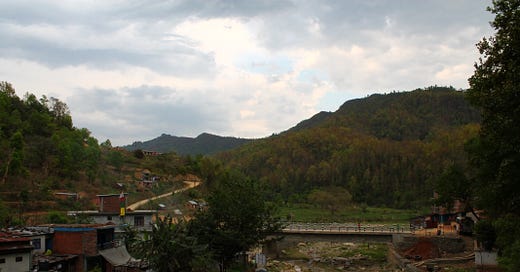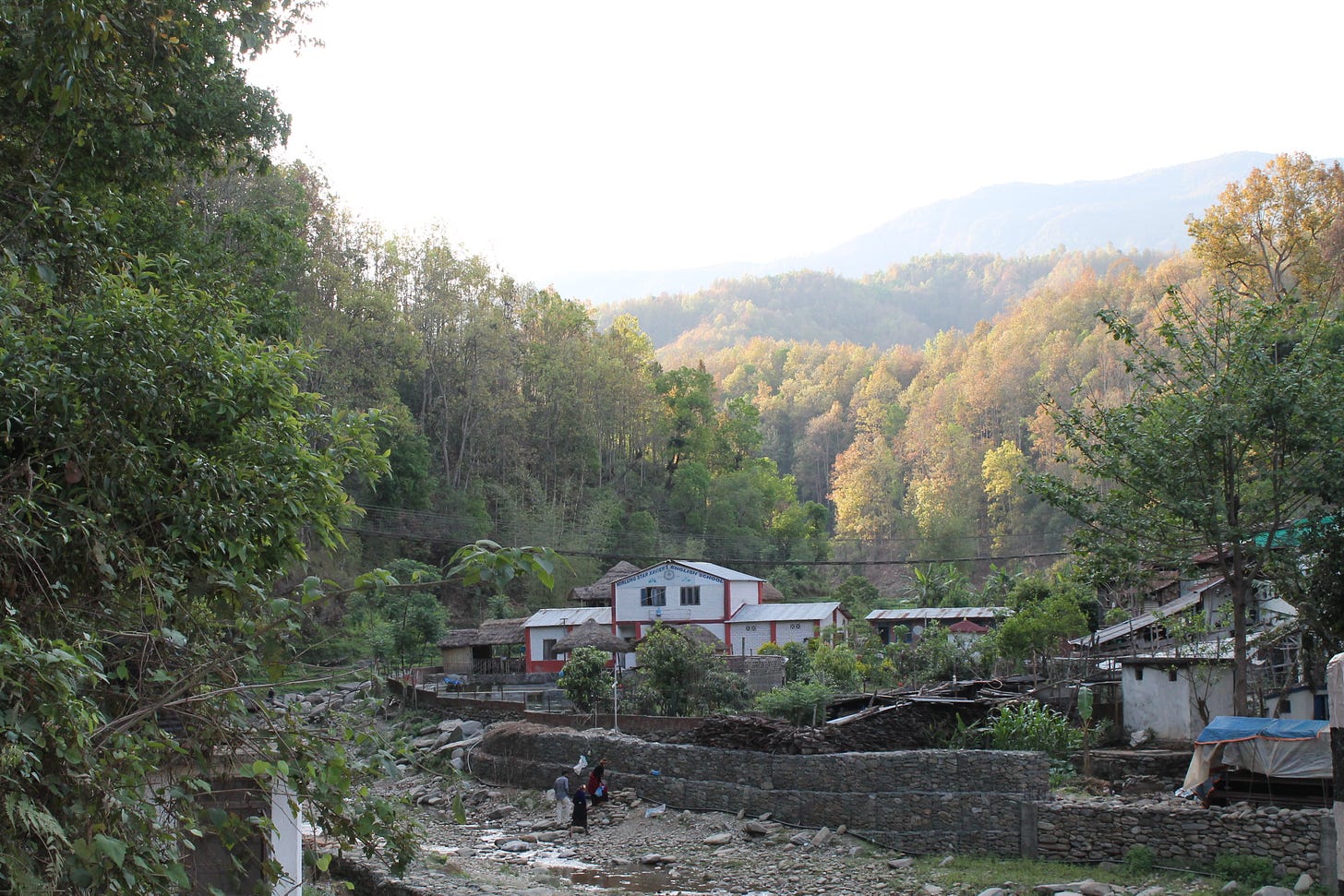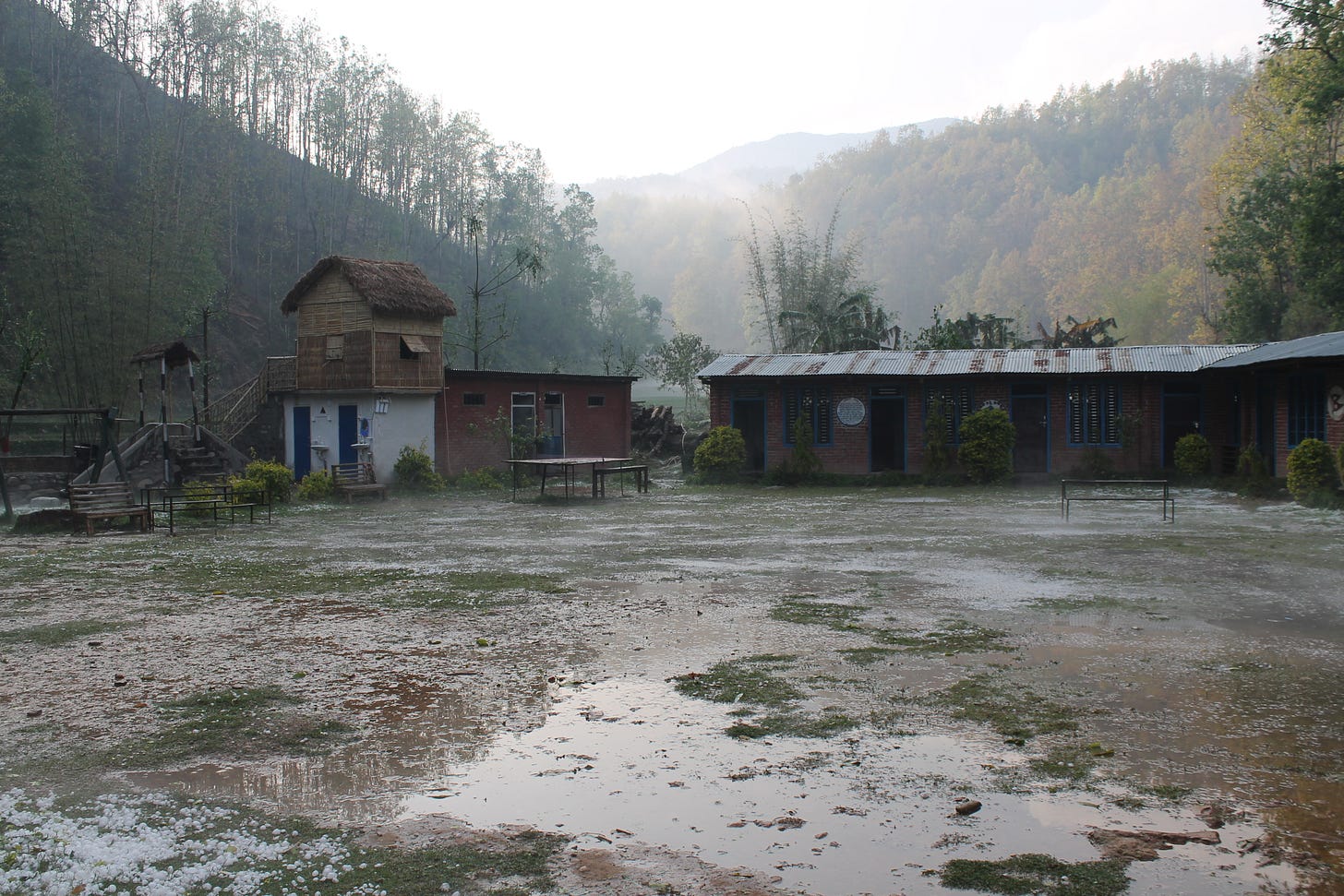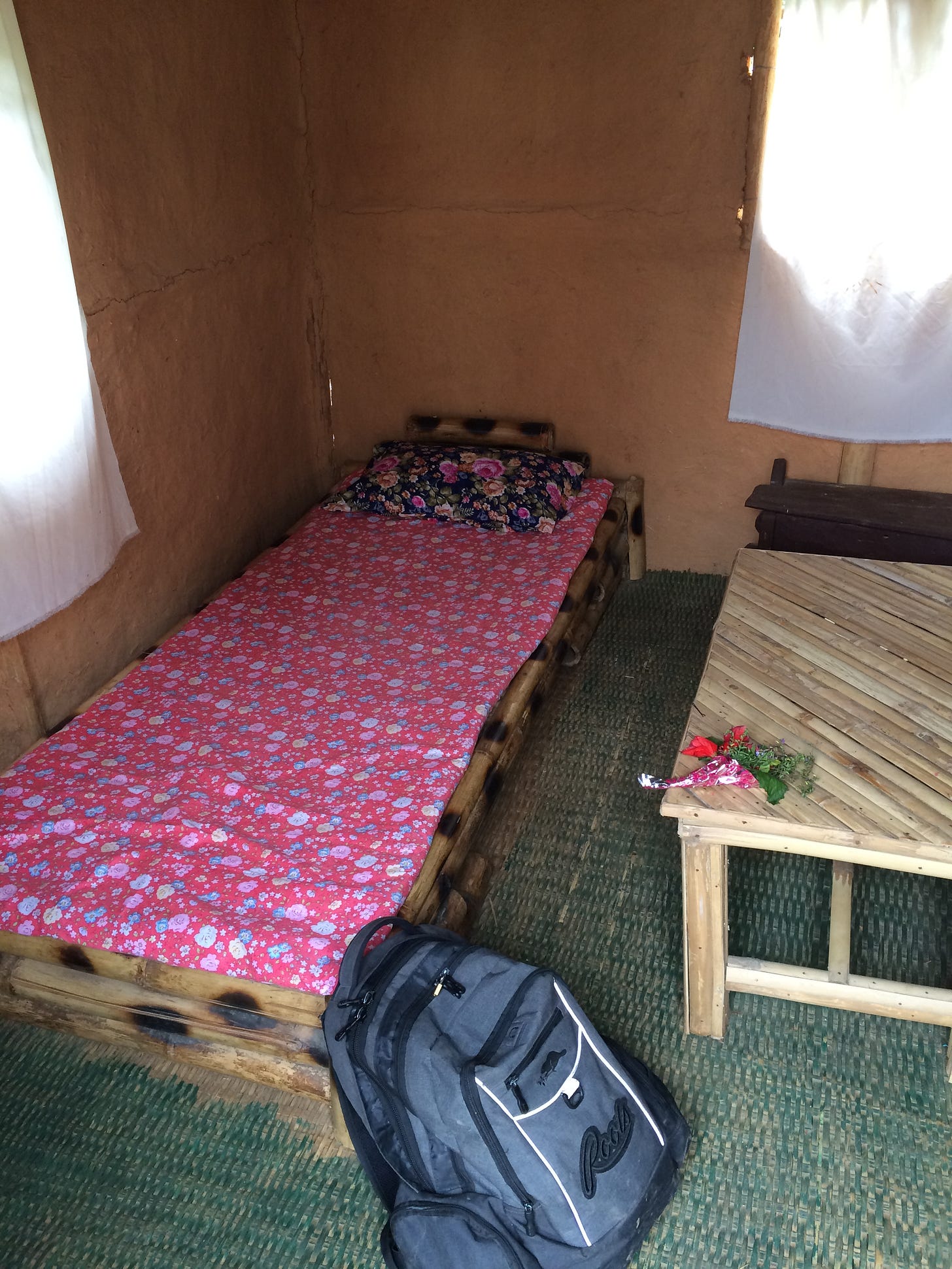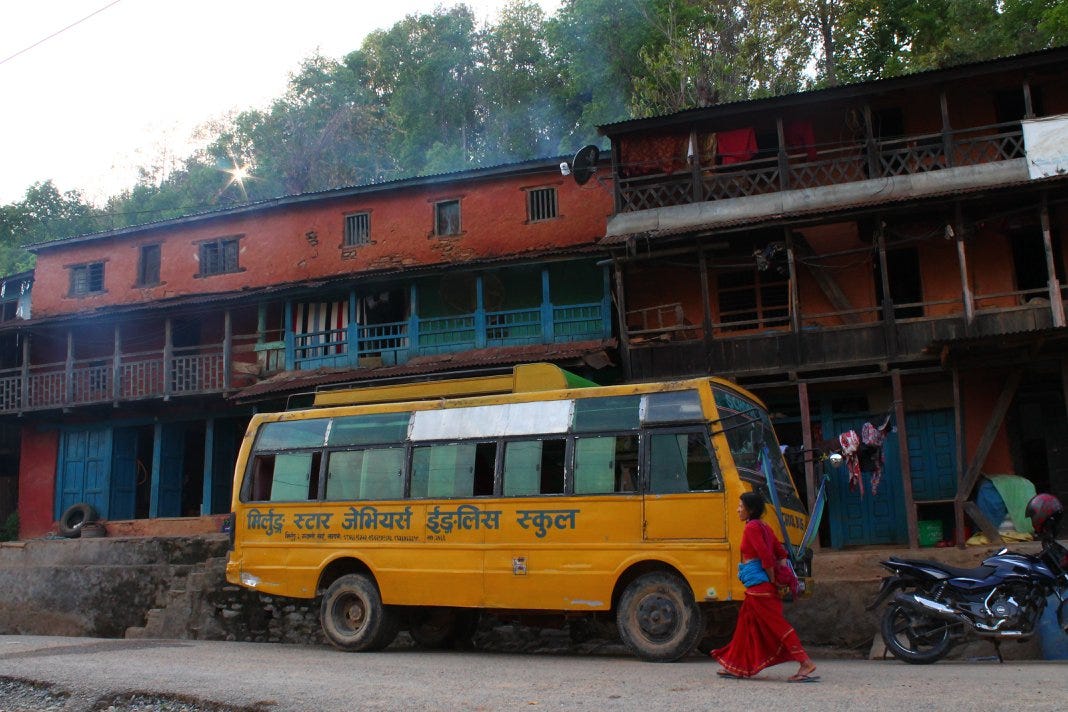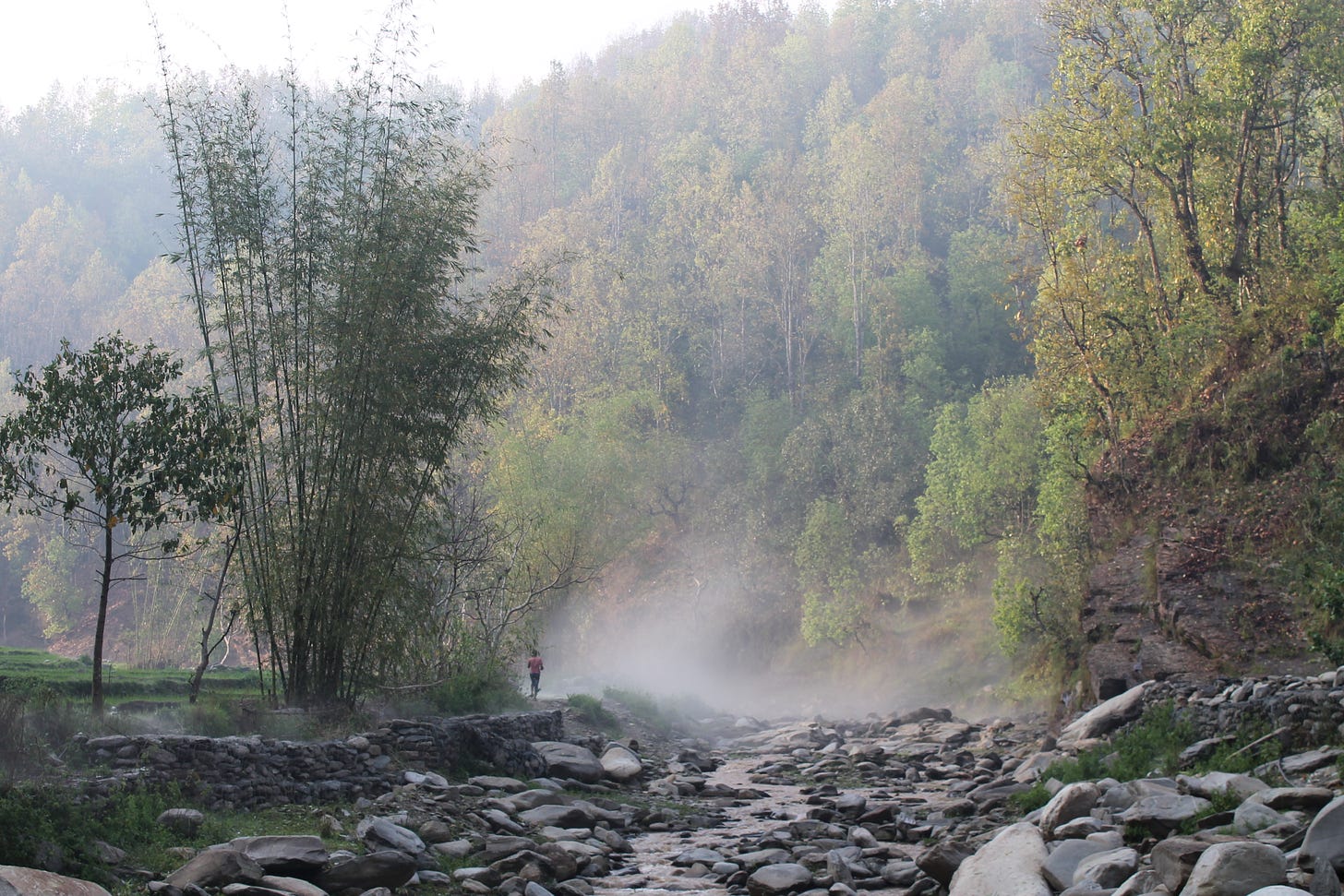Attaining fulfillment and happiness is not about what we have but what we can give.
This blog post was originally published on my website here.
If you haven’t yet subscribed, do now so you get my two FREE guides ‘Money Saving Tips for a More Meaningful Trip’ and ‘How to Prepare and Pack for Your First Solo Trip’.
I walked through the gate of the school grounds behind my host, Laxmi, who met me at the bus stop a few minutes earlier. A tiny hand appeared in front of my face and smeared vermillion pigment across my forehead.
“Welcome to Chandrawati,” Xavier, Laxmi’s eldest son, said. Her youngest son Felix was in the father’s arms, his fingertips covered in the red powder. Laxmi is a mother of two boys, and she and her husband Chhabi run an elementary school in the tiny village of Chandrawati in central Nepal.
Kathmandu to the Valley of Villages
From Kathmandu, I embarked on a 7-hour bus journey to the school where I volunteered for two weeks.
The final bus ride was in a white minivan where I sat shoulder to shoulder with other villagers, their burlaps sacks of rice and cabbage resting by my feet. The locals and I were commuting to the center of the Tanahun district, where quaint villages like Chandrawati exist on the hillsides.
Leafy ferns line the river bed where women squat among boulders to beat the dirt out of their laundry. Shepherds whistled and barked orders at their queue of goats trotting in front of them on dirt paths.
If skies are clear, the snowy peaks of the Annapurnas are visible in the distance. Time passes by slower here, far away from the dust and traffic of Kathmandu.
Bare Classrooms and Mud Huts
Mirlung Star Xavier’s School lies beside the shallow river that divides the village in two.
Several metal-roofed classrooms with concrete walls form a semi-circle around a broad grass field. Windows are without glass panes, and the doors are vacant frames open to the greenery outside.
Each class is furnished only with three rows of desks worn down at the edges and a dusty green chalkboard.
Laxmi led me around the back of the two-story house where the family lives. There’s a thatched-roofed hut constructed with mud and wood adjacent to a concrete-walled pond.
“You will stay in here with another volunteer,” Laxmi pushed the door open and nodded for me to enter. Two cots filled with hay on short wood frames have a pillow placed on one end.
While I stayed in Chandrawati, the school was on spring break. The other volunteers and I repainted classroom walls, organized spring camp activities, and weeded garden beds.
A Dinner Invitation
On my second day in Chandrawati, myself and the volunteers were busy clearing out the flower beds.
“Come my house,” the handyman said as I was gardening, “My wife make beautiful mint sauce with goat.”
He spoke Nepali and broken English, but the language gap didn’t hamper his generosity.
Another volunteer and I walked along the dirt road to his house that night.
Their single-room home was a simple wood hut topped with scrap metal. It was smaller than a bachelor apartment and devoid of furniture. Thin fabric sheets separated the seating area from the wood-cooking fire and a mattress in the corner.
I sat with his wife and three children on a carpet beside a kerosene lamp as they awaited my opinion of the curry.
“It’s amazing,” I gave two thumbs up.
I don’t usually like mint sauces, but I couldn’t deny the delicious pairing of herbs and tender goat. The whole family beamed and insisted I have seconds. Just as Laxmi, Chhabi, Xavier, and Felix welcomed me to their home, I instantly felt part of their family.
Big Hearts, Strong Drinks
I woke up to the sounds of chickens clucking and roosters crowing outside my mud hut. Chhabi invited me to visit his sister in a village higher up the mountain.
“She’s making raksi.” Chhabi tells me.
It’s the clear rice wine I tried yesterday night after dinner. With the taste of watered-down vodka but a seemingly higher alcohol content, I winced after each slow sip.
I hopped on the back of Chhabi’s motorbike and held tightly to the bottom of my seat. He revved the engine and swerved up the road, leaning into each curve that winds along the incline of the hillside.
The chickens at his sister’s property are not in an enclosed pen like the ones beside my mud hut. They are pecking at the grass around her home freely.
Chhabi’s sister squatted beside a wood-burning fire. She opened the massive metal lid to the pot resting on the flames and stirred the liquid inside.
A cloud of steam emerged and flew into her face as bubbling foam rose to the brim of the pot. She waved at me with bright eyes. I waved hello back.
“We’re going to have a glass now before we go.” Chhabi grabs two metal cups and fills them with the hot liquid directly from the pot.
Chhabi’s sister places a bowl in my lap of dry instant noodles, dressed with diced red onion and green chilis. I’ve noticed that instant noodles are a popular snack among the village children.
Chhabi and his sister’s hospitality is as heartwarming as the raksi and spicy noodle combination. While my stomach struggles to settle from the hot raksi, it gurgles in retaliation to the spicy snack I layer on top.
Momo Folding and Pond Fishing
My stomach had a greater tolerance for the food I ate in Chandrawati. My favorite is momos which I prepared with the two ladies hired to cook meals for the students at the school.
They laid the palm-sized flattened circle on dough in the middle of their hands and spoons in a dollop of the cabbage, carrot, onion, and spice mixture in the center.
The free hand created identical tiny folds starting from one end of the dough while the momo-holding hand spun around until a perfect sickle of folds lined half of the handmade dumpling.
Most meals I ate were vegetarian, like the momos I tried (and failed) to fold so intricately as the cooks did.
One exception to their vegetarian diet is the fish that are farmed in the man-made ponds used by villagers in the area.
“My friend needs help fishing today,” Chhabi explained, “You want to come see how we do it?”
I joined Chhabi on the hour-long walk down the road and up a steep flight of rice paddy steps to his friend's farm.
Four men, including Chhabi, and six of their children gather around a rectangular concrete pool similar to the one adjacent to my mud hut.
The children stared at me like I was an exotic zoo animal they’d never seen in real life before. They don’t see tourists like me, a young Canadian woman, often.
“What your name?” they asked simultaneously. “What’s your country?”
I sat with them and answered their questions while the fishing process began.
Two men jumped into the pond holding one corner of a broad net, while the other two men stood above them holding the opposite two corners.
As the men in the pool waded across the other end, the net pushed the fish to one end of the pool against the net.
The children ran and giggled as they caught fish flying out of the pool and placed the escaped fish into buckets of water.
The men grabbed the mature fish with their bare hands, tossed them into the same white buckets the kids were using, and threw the younger fish back into the pond.
“Friends always gather to help one another when it’s time to fish,” Chhabi said. Whoever assists brings some fish home to their family, and the owner sells the remaining fish in the village markets.
Everyone in the villages collaborates as a team, whether brewing raksi or dragging a fishing net across a pond.
A Community Founded on Co-operation and Generosity
I didn’t learn how to fold momos properly or acquire the taste for raksi during my stay in Chandrawati, but what the villagers taught me about their way of life changed me forever.
Maybe it’s the strength of the raksi they consume, but either way, the villagers sported smiles that never faltered. No matter how small their home was or what little resources they had, I always noticed people were eager and happy to give.
Acting kindly and being generous isn’t about securing a favor from someone else in the future—it’s a way to bring us closer together. The people in Chandrawati taught me that love and joy are within every one of us, and that love and joy are meant to be shared.
In some cases, happiness means sharing a pot of mint curry goat, a glass of steaming raksi, or a bucket of fresh fish.
Don't forget to Follow me on Twitter, Facebook, Instagram, and YouTube and to stay up to date on my latest adventures and writing!
Info about Chandrawati
I volunteered for the school via their Workaway profile. Setting up an account with Workaway is easy. There’s a yearly fee to use the platform. You can also learn more about the village and the school on the school’s Facebook page.
From Kathmandu, you can take local buses to Dumre. From Dumre, minivans are available toward Chandrawati that stop at other villages along the way.
There aren’t hotels in Chandrawati (there are hotels in Dumre), so if you want to stay in a village, your best bet is to find a volunteer placement with a local.
If you’re interested in organic farming, here’s a page to search for volunteer placements on farms in Nepal:
https://wwoofnepal.net/
Have questions about traveling solo and volunteering abroad? Send me a message! Always happy to encourage and help those new to solo travel :)


